1995 OLDSMOBILE SILHOUETTE stop start
[x] Cancel search: stop startPage 46 of 390
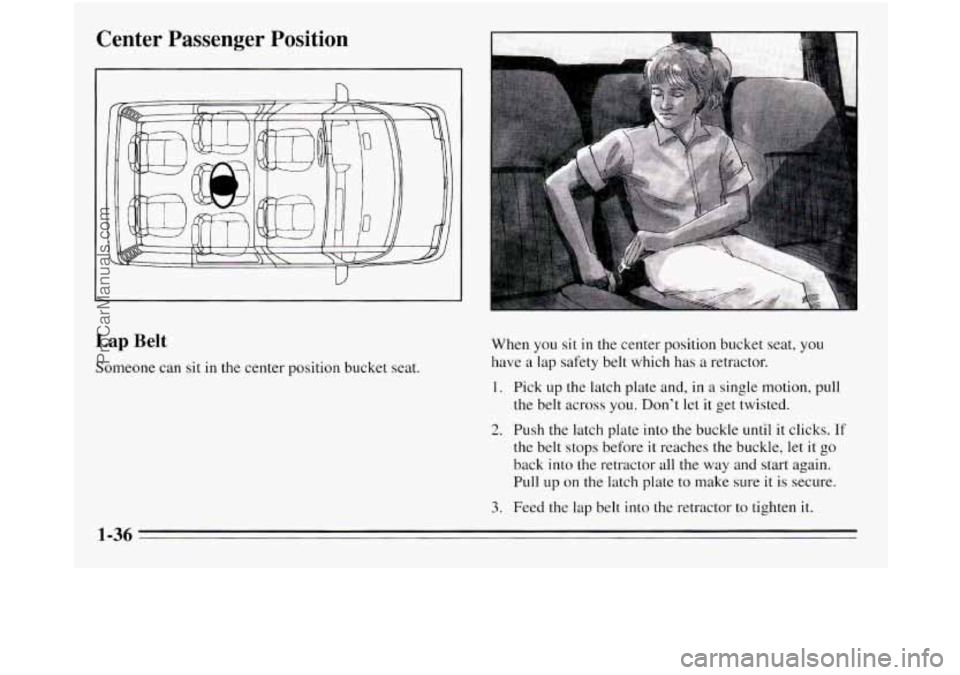
Center Passenger Position
Lap Belt
Someone can sit in the center position bucket seat. When
you sit in the center position bucket seat, you
have
a lap safety belt which has a retractor.
1.
2.
3.
Pick up the latch plate and, in a single motion, pull
the belt across
you. Don’t let it get twisted.
Push the latch plate into the buckle until it clicks. If
the belt stops before it reaches the buckle, let it go
back into the retractor all the way and start again.
Pull up on the latch plate to make sure it is secure.
Feed the lap belt into the retractor to tighten it.
1-36
ProCarManuals.com
Page 92 of 390
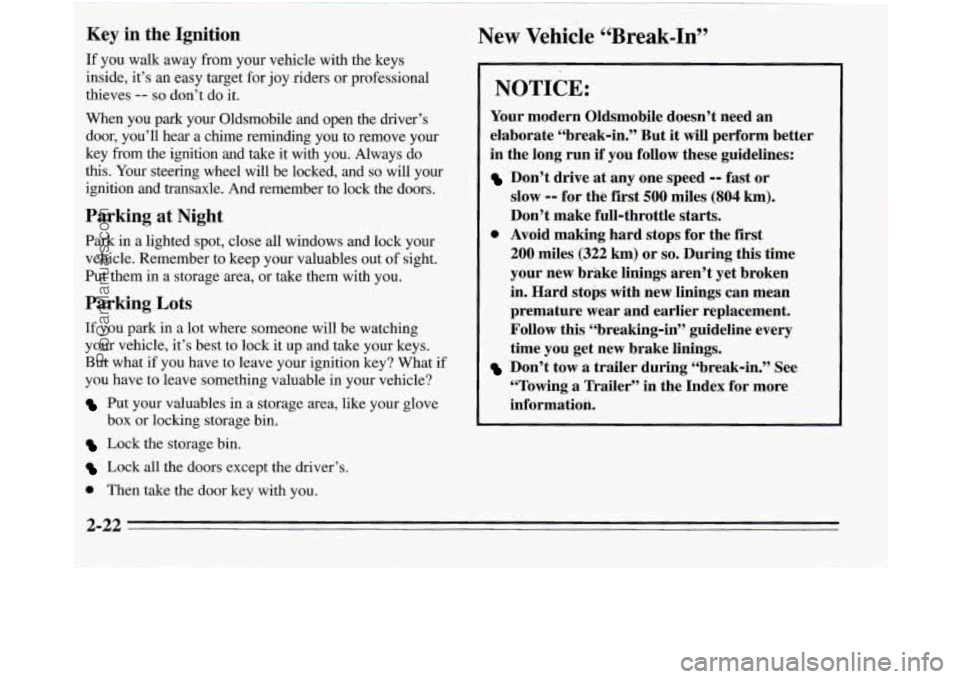
Key in the Ignition
If you walk away from your vehicle with the keys
inside, it’s an easy target for joy riders or professional
thieves
-- so don’t do it.
New Vehicle ''Break-in"
When you park your Oldsmobile and open the driver’s
door’ you’ll hear a chime reminding you to remove your
key from the ignition and take it with you. Always
do
this. Your steering wheel will be locked, and so will your
ignition and transaxle. And remember to lock the doors.
Parking at Night
Park in a lighted spot, close all windows and lock your
vehicle. Remember to keep your valuables out
of sight.
Put them in a storage area, or take them with you.
Parking Lots
If you park in a lot where someone will be watching
your vehicle, it’s best to lock it up and take your keys.
But what if you have to leave your ignition key? What if
you have
to leave something valuable in your vehicle?
Put your valuables in a storage area, like your glove
box or locking storage bin.
Lock the storage bin.
Lock all the doors except the driver’s.
0 Then take the door key with you.
NOTICE:
Your modern Oldsmobile doesn’t need an
elaborate “break-in.” But it
will perform better
in the long run if you follow these guidelines:
Don’t drive at any one speed -- fast or
slow
-- for the first 500 miles (804 km).
Don’t make full-throttle starts.
200 miles (322 km) or so. During this time
your new brake linings aren’t yet broken
in. Hard stops with new linings can mean
premature wear and earlier replacement.
Follow this “breaking-in” guideline every
time you get new brake linings.
Don’t tow a trailer during “break-in.” See
“Towing
a Trailer” in the Index for more
information.
0 Avoid making hard stops for the first
2-22
ProCarManuals.com
Page 94 of 390
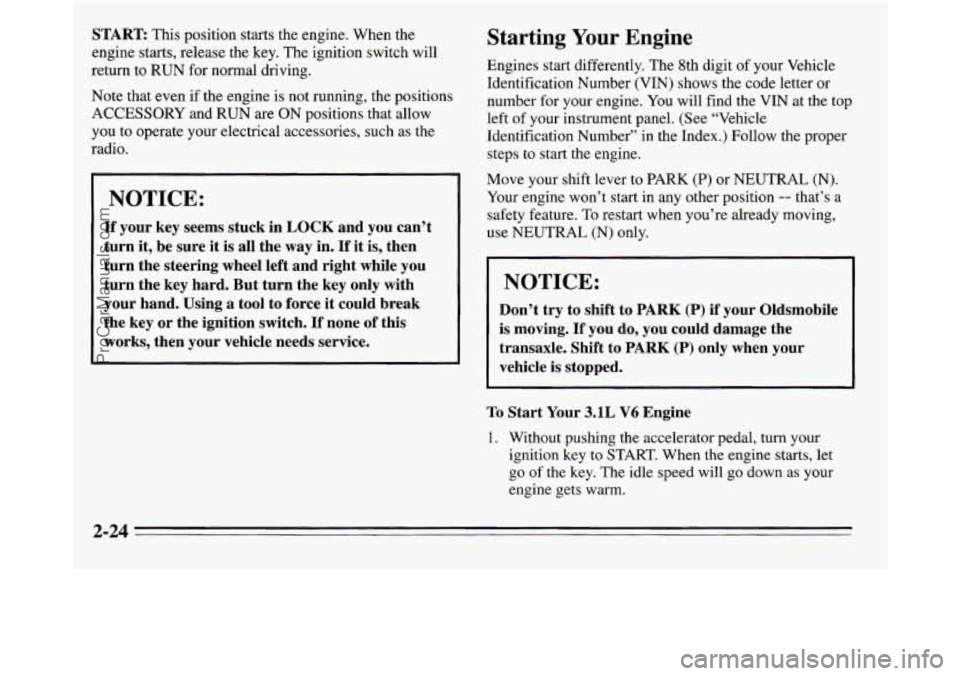
START This position starts the engine. When the
engine starts, release the key. The ignition switch will
return to RUN for normal driving.
Note that even if the engine is not running, the positions
ACCESSORY and RUN are
ON positions that allow
you to operate your electrical accessories, such as the
radio.
NOTICE:
If your key seems stuck in LOCK and you can’t
turn it, be sure
it is all the way in. If it is, then
turn the steering wheel left and right while you
turn the key hard. But turn the key only with
your hand. Using
a tool to force it could break
the key or the ignition switch. If none of this
works, then your vehicle needs service.
Starting Your Engine
Engines start differently. The 8th digit of your Vehicle
Identification Number (VIN) shows the code letter or
number for your engine. You will find the VIN at the top
left
of your instrument panel. (See “Vehicle
Identification Number” in the Index.) Follow the proper
steps to start the engine.
Move your shift lever to PARK (P) or NEUTRAL
(N).
Your engine won’t start in any other position -- that’s a
safety feature. To restart when you’re already moving,
use NEUTRAL (N) only.
NOTICE:
Don’t try to shift to PARK (P) if your Oldsmobile
is moving.
If you do, you could damage the
transaxle. Shift to
PARK (P) only when your
vehicle is stopped.
To Start Your 3.1L V6 Engine
1. Without pushing the accelerator pedal, turn your
ignition key to START. When the engine starts, let
go of the key. The idle speed will go down as your
engine gets warm.
2-24
ProCarManuals.com
Page 95 of 390
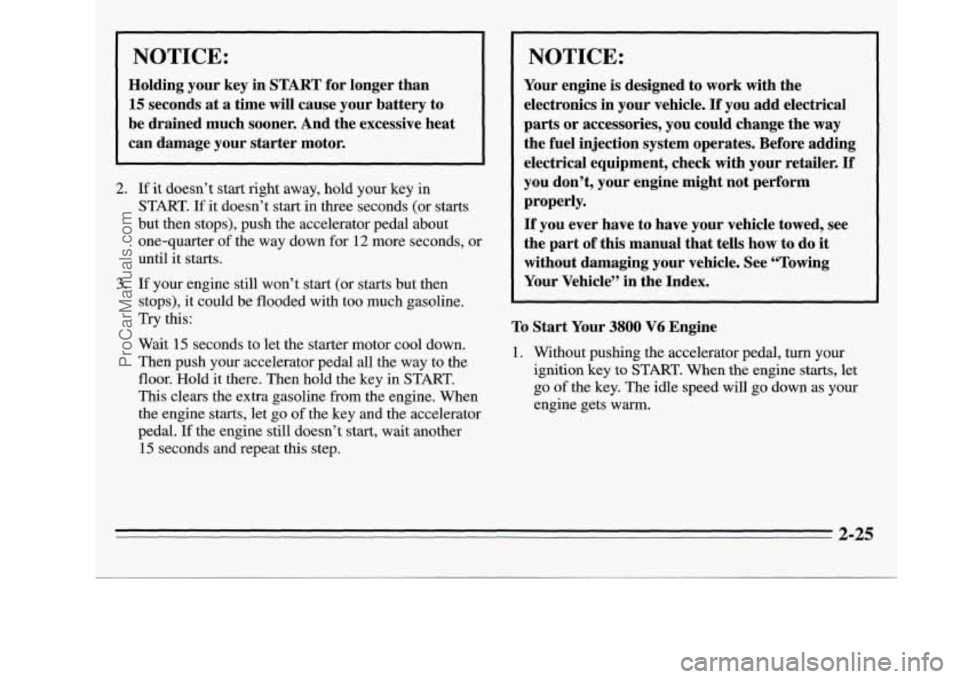
NOTICE:
Holding your key in START for longer than
15 seconds at a time will cause your battery to
be drained much sooner. And the excessive heat
can damage your starter motor.
2. If it doesn’t start right away, hold your key in
START.
If it doesn’t start in three seconds (or starts
but then stops), push the accelerator pedal about
one-quarter of the way down for
12 more seconds, or
until it starts.
3. If your engine still won’t start (or starts but then
stops), it could
be flooded with too much gasoline.
Try this:
Wait
15 seconds to let the starter motor cool down.
Then push your accelerator pedal all the way to the
floor. Hold it there. Then hold the key in START.
This clears the extra gasoline from the engine. When
the engine starts, let
go of the key and the accelerator
pedal.
If the engine still doesn’t start, wait another
15 seconds and repeat this step.
NOTICE:
Your engine is designed to work with the
electronics in your vehicle.
If you add electrical
parts or accessories, you could change the way
the fuel injection system operates. Before adding
electrical equipment, check with your retailer.
If
you don’t, your engine might not perform
properly.
If you ever have to have your vehicle towed, see
the part of this manual that
tells how to do it
without damaging your vehicle. See “Towing
Your Vehicle” in the Index.
To Start Your 3800 V6 Engine
1. Without pushing the accelerator pedal, turn your
ignition
key to START. When the engine starts, let
go of the key. The idle speed will go down as your
engine gets
warm.
2-25
ProCarManuals.com
Page 96 of 390
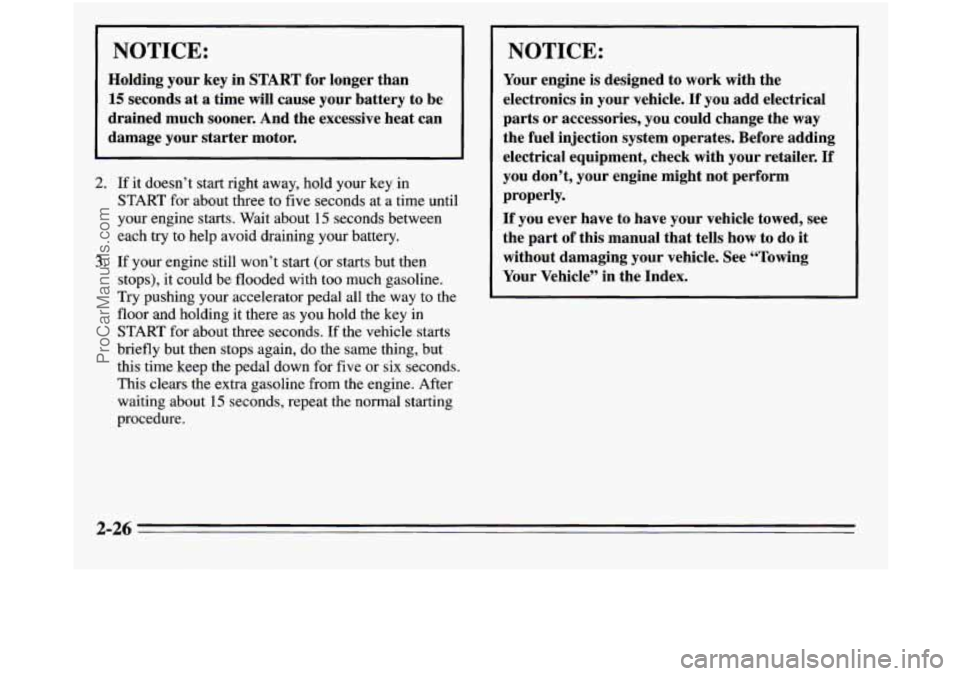
NOTICE:
Holding your key in START for longer than
15 seconds at a time will cause your battery to be
drained much sooner. And the excessive heat can
damage your starter motor.
2. If it doesn’t start right away, hold your key in
START
for about three to five seconds at a time until
your engine starts. Wait about
15 seconds between
each try to help avoid draining your battery.
3. If your engine still won’t start (or starts but then
stops), it could be flooded with too much gasoline.
Try pushing your accelerator pedal all the way
to the
floor and holding it there as you hold the key in
START for about three seconds. If the vehicle starts
briefly but then stops again, do the same thing, but
this time keep the pedal down for five or six seconds.
This clears the extra gasoline from the engine. After
waiting about
15 seconds, repeat the normal starting
procedure.
NOTICE:
Your engine is designed to work with the
electronics in your vehicle.
If you add electrical
parts or accessories, you could change the
way
the fuel injection system operates. Before adding
electrical equipment, check with your retailer.
If
you don’t, your engine might not perform
If you ever have to have your vehicle towed, see
the part of this manual that tells how to do
it
~ without damaging your vehicle. See “Towing
Your Vehicle” in the Index.
, properly.
2-26
ProCarManuals.com
Page 99 of 390
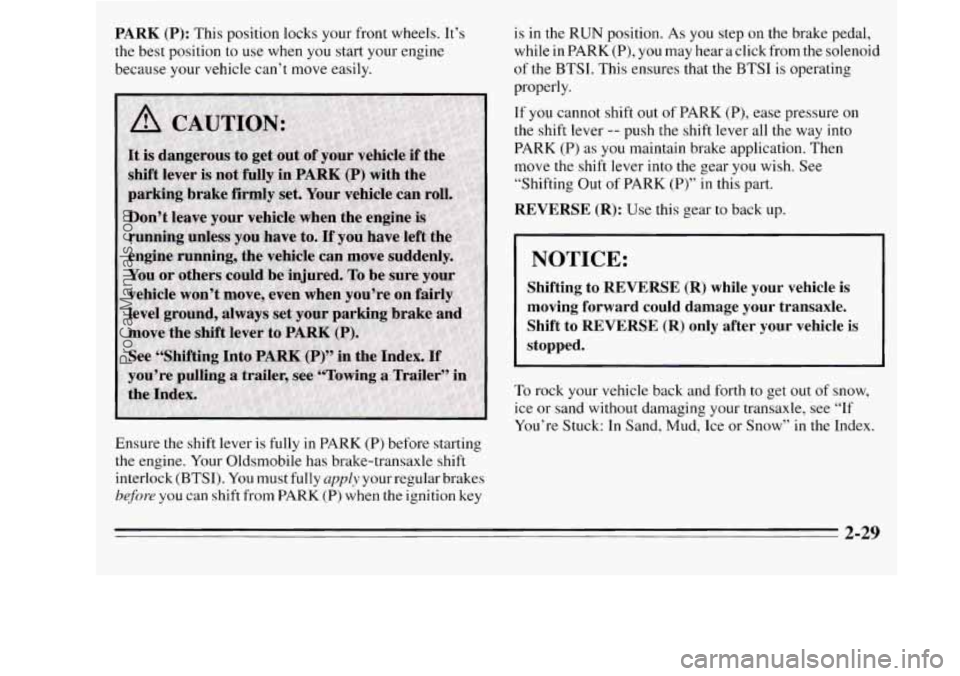
PARK (P): This position locks your front wheels. It’s
the best position to
use when you start your engine
because your vehicle can’t move easily.
Ensure the shift lever
is fully in PARK (P) before starting
the engine. Your Oldsmobile has brake-transaxle shift
interlock
(BTSI). You must fully apply your regular brakes
before you can shift from PARK (P) when the ignition key is
in the RUN position.
As you step on the brake pedal,
while in PARK (P),
you may hear a click from the solenoid
of the
BTSI. This ensures that the BTSI is operating
properly.
If you cannot shift out of PARK (P), ease pressure on
the shift lever
-- push the shift lever all the way into
PARK (P) as you maintain brake application. Then
move the shift lever into the gear you wish. See
“Shifting Out of PARK
(P)” in this part.
REVERSE (R): Use this gear to back up.
I NOTICE: I
Shifting to REVERSE (R) while your vehicle is
moving forward could damage your transaxle. Shift to REVERSE
(R) only after your vehicle is
stopped.
To rock your vehicle back and forth to get out of snow,
ice or sand without damaging your transaxle, see “If
You’re Stuck: In Sand,
Mud, Ice or Snow” in the Index.
2-29
ProCarManuals.com
Page 129 of 390
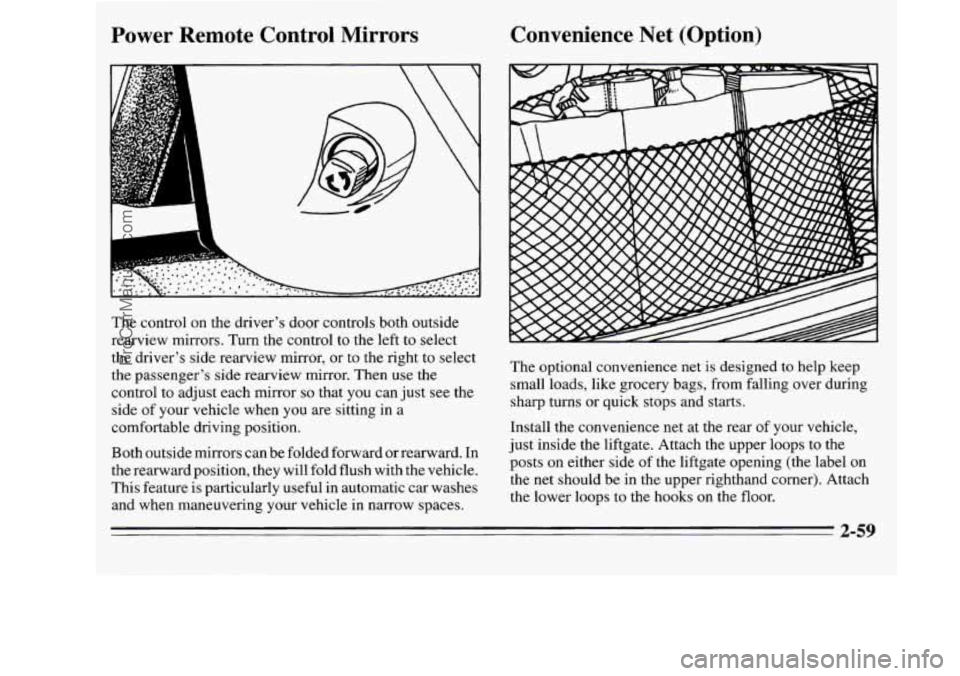
Power Remote Control Mirrors Convenience Net (Option)
L
The control
on the driver’s door controls both outside
rearview mirrors. Turn the control to the left to select
the driver’s side rearview mirror, or
to the right to select
the passenger’s side rearview mirror.
Then use the
control to adjust each mirror
so that you can just see the
side of your vehicle when you are sitting in a
comfortable driving position.
Both outside mirrors can be folded forward or rearward. In
the rearward position, they will fold flush with the vehicle.
This feature is particularly useful in automatic car washes
and when maneuvering your vehicle in narrow spaces. The optional
convenience net
is designed to help keep
small loads, like grocery bags, from falling over during
sharp turns or quick stops and starts.
Install the convenience net at the rear of your vehicle,
just inside the liftgate. Attach the upper loops to the
posts on either side of the liftgate opening (the label on
the net should be in the upper righthand corner). Attach
the lower loops
to the hooks on the floor.
2-59
ProCarManuals.com
Page 147 of 390
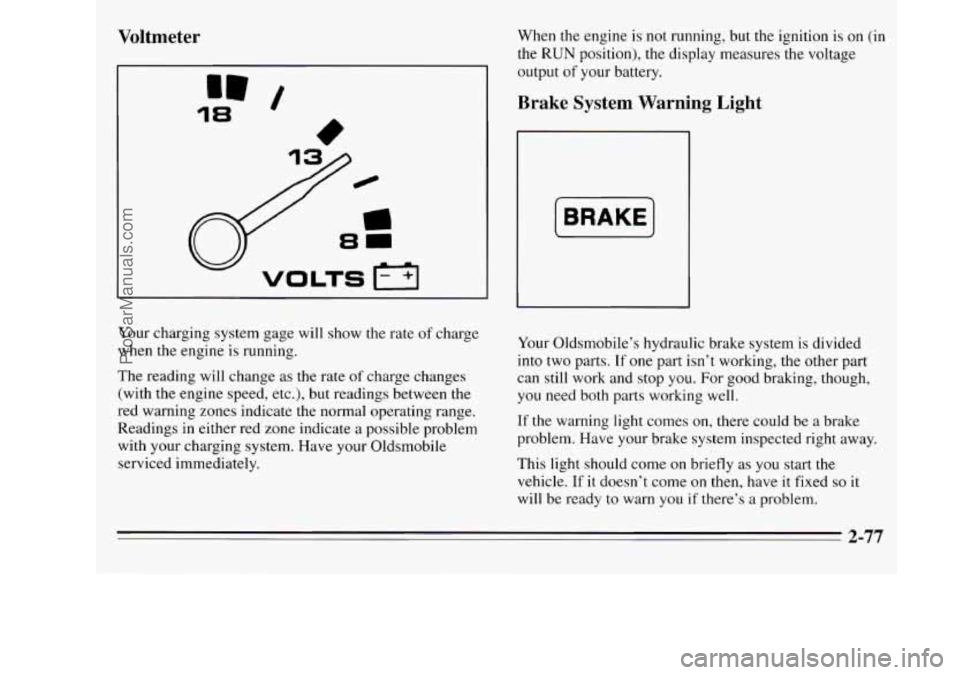
Voltmeter
18
” /
When the engine is not running, but the ignition is on (in
the RUN position), the display measures the voltage
output
of your battery.
Brake System Warning Light
[BRAKE]
Your charging system gage will show the rate of charge
when the engine is running.
The reading will change as the rate
of charge changes
(with the engine speed, etc.), but readings between the
red warning zones indicate the normal operating range.
Readings in either red zone indicate
a possible problem
with your charging system. Have your Oldsmobile
serviced immediately. Your
Oldsmobile’s hydraulic brake system is divided
into two parts.
If one part isn’t working, the other part
can still work and stop
you. For good braking, though,
you need both parts working well.
If the warning light comes on, there could be a brake
problem. Have your brake system inspected right away.
This light should come on briefly as you start the
vehicle.
If it doesn’t come on then, have it fixed so it
will be ready to warn
you if there’s a problem,
2-77
ProCarManuals.com